#largest fort in India
Explore tagged Tumblr posts
Text
Excerpt from this story from National Geographic. All photographs byJoel Sartore:


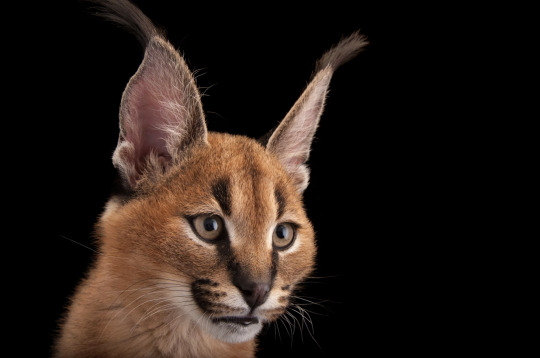
CARACAL | CARACAL CARACAL Consummate predators, some small wildcats can take down larger prey. The caracal of Asia and Africa is less than two feet tall but has been filmed leaping over nine-foot fences to prey on sheep. PHOTOGRAPHED AT COLUMBUS ZOO AND AQUARIUM, OHIO
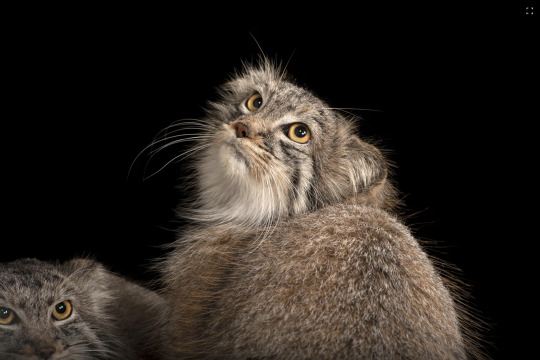
PALLAS'S | CATOTOCOLOBUS MANUL A famously grumpy expression made this Central Asian species an Internet star. Conservationists hope the cat’s celebrity will help save its habitat from encroaching farms and other threats. PHOTOGRAPHED AT COLUMBUS ZOO AND AQUARIUM, OHIO
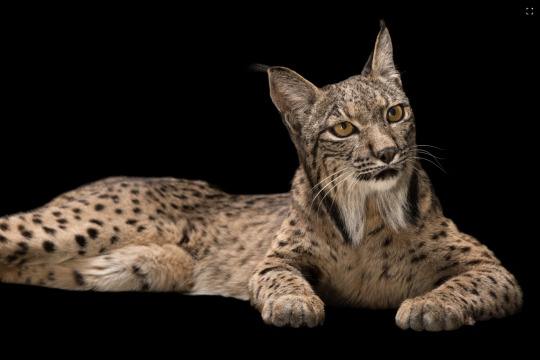
IBERIAN LYNX | LYNX PARDINUS One of the world’s rarest cats, the Iberian lynx is slowly increasing in number as scientists release captive-raised cats and boost populations of rabbits, the lynx’s staple food. PHOTOGRAPHED AT MADRID ZOO AND AQUARIUM, SPAIN

FISHING CAT | PRIONAILURUS VIVERRINUS The cat may look peculiar, but it’s perfectly adapted to its lifestyle: Big eyes help snare prey underwater, double-coated fur keeps out the wet, and partially webbed feet and a muscular, rudderlike tail aid in swimming. PHOTOGRAPHED AT POINT DEFIANCE ZOO AND AQUARIUM IN TACOMA, WASHINGTON
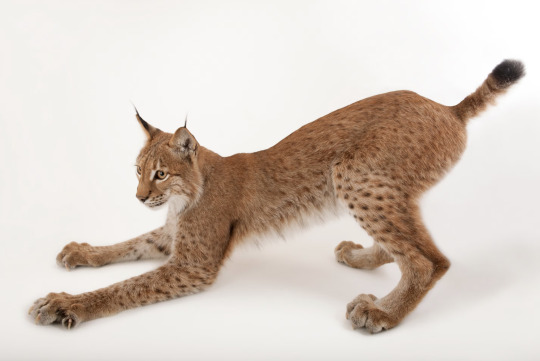
EURASIAN LYNX | LYNX LYNX The largest of the four lynx species, the Eurasian lynx also has a huge range, including most of Europe and parts of Central Asia and Russia. Unlike many other small cats, its population is stable and threats are relatively low—although some isolated subgroups are critically endangered. PHOTOGRAPHED AT COLUMBUS ZOO AND AQUARIUM, OHIO

JAGUARUNDI | SHERPAILURUS YAGOUAROUNDI With long, squat bodies and tiny ears, jaguarundis are otterlike in appearance. Thanks to their huge range—parts of Mexico, Central America, and South America—and lack of widespread hunting, the cat is considered a species of least concern. PHOTOGRAPHED AT BEAR CREEK FELINE CENTER, FLORIDA

LEOPARD CAT | PRIONAILURUS BENGALENSIS. PHOTOGRAPHED AT ANDERSON, INDIANA
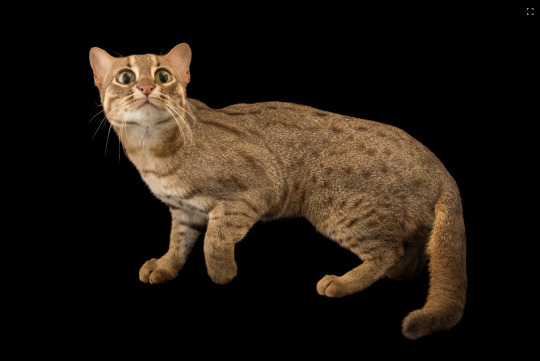
RUSTY-SPOTTED CAT | PRIONAILURUS RUBIGINOSUS The smallest of the small cats, the rusty-spotted cat, a native of India and Sri Lanka, can weigh as little as two pounds. Not much is known about the speckled feline, but destruction of habitat, hunting, and hybridizing with domestic cats are threats. PHOTOGRAPHED AT EXMOOR ZOO, ENGLAND

AFRICAN GOLDEN CAT | CARACAL AURATA Inhabiting the rain forests of West and Central Africa, this species is threatened by forest loss and bush-meat hunters. This seven-year-old male, Tigri, is likely the only cat of its kind in captivity. PHOTOGRAPHED AT PARC ASSANGO, LIBREVILLE, GABON

SAND CAT | FELIS MARGARITA. PHOTOGRAPHED AT CHATTANOOGA ZOO, TENNESSEE

CANADA LYNX | LYNX CANADENSIS Like the Iberian lynx, the Canada lynx is a specialist hunter, preying almost exclusively on snowshoe hare. The North American species has giant paws that help it run through deep snow after prey. PHOTOGRAPHED AT POINT DEFIANCE ZOO AND AQUARIUM, WASHINGTON

MARGAY | LEOPARDUS WIEDII. PHOTOGRAPHED AT CINCINNATI ZOO AND BOTANICAL GARDEN, OHIO
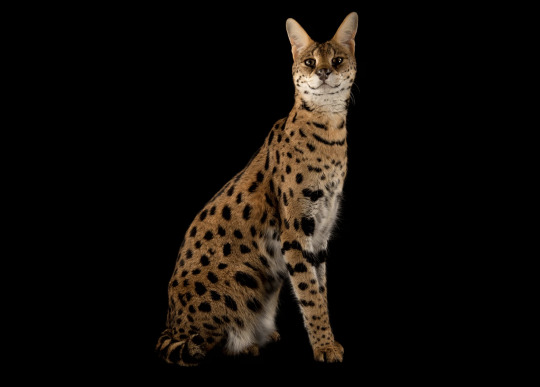
SERVAL | LEPTAILURUS SERVAL. PHOTOGRAPHED AT FORT WORTH ZOO, TEXAS
1K notes
·
View notes
Text
The East India Company ships
The East and West India Company ships were not ship types in the usual sense. They were generic terms for a series of merchant ship types that travelled between Europe and the overseas colonies in the East and West. Common features of these ships were three masts, several cannons and a high bulwark to make it more difficult for attackers to board them. Their valuable cargo made the ships attractive targets, so they often travelled in convoys, accompanied by medium-armed merchant ships or frigates for protection. But let's go into more detail.

The East Indiaman 'Earl of Abergavenny', off Southsea, by Thomas Luny 1801
The ships of the East India Company were the ships of the English East India Company, a public limited company (shipowners at the early time of the East India Company contributed their ships to the company and received a certain share in the company in return. They received a proportionate share of the company's overall profits and received a dividend even if their own ship was lost, since the 18th century the company build their own ones as well.) which traded with Asia from 1600 to 1834. The company had a monopoly on trade with the East Indies, China and other regions, and its ships carried goods such as spices, tea, silk, cotton, porcelain and opium. The company also played an important role in the colonisation and administration of India and other territories.

East India Company ships at Deptford, by English School, c. 1660
The ships of the East India Company were known as East Indiamen or as Indiamen and were among the largest and most modern of their time. They were designed to withstand long voyages, carry heavy cargoes and defend themselves against pirates and enemy ships. They were also equipped with cannons and muskets and had a crew of sailors, soldiers, officers and passengers. Because of the need to carry heavy cannons, the hull of the East Indiamen - like most warships of the time - was much wider at the waterline than on the upper deck, so the guns on the upper deck were closer to the centreline to increase stability. This is known as a tumblehome. The ships usually had two complete decks for accommodation within the hull and a raised aft deck. The aft deck and the deck below were lit by galleries with square windows at the stern. To support the weight of the galleries, the hull lines were full towards the stern. As mentioned above, the ships were armed and painted to look like a warship and an attacker could not be sure if the embrasures were real or just painted, and some Indiamen carried a substantial armament.
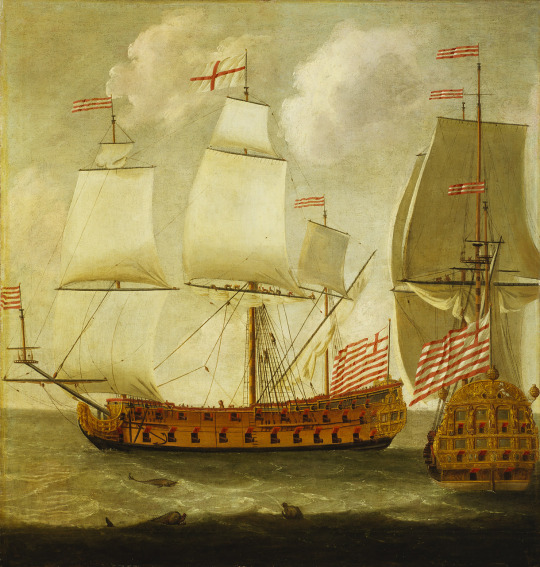
Two views of an East Indiaman of the time of King William III, by Issac Sailmaker, 1685
The Royal Navy acquired several East Indiamen during the Napoleonic Wars and made them fourth rate ships (e.g. HMS Weymouth and HMS Madras), perpetuating the confusion of military ships with merchant vessels as prizes. In some cases, the East Indiamen successfully fended off attacks by the French. One of the most famous incidents occurred in 1804 when a fleet of East India ships and other merchant vessels under Commodore Nathaniel Dance successfully fought off a squadron commanded by Admiral Linois at the Battle of Pulo Aura in the Indian Ocean. And during this time, some of the ships were even travelling under the protection of a Letter of Marque, which allowed them to make their own prizes.

The East Indiaman 'Prince of Wales' disembarking troops off Gravesend, 1845, by John Lynn, 1845 or later - She was built by Green's of Blackwall in 1842 to a design known as that of the "Blackwall Frigates" - Indiamen with the single-decked appearance of frigates.
The ships of the India Companies were not only involved in trade, but also in exploration, diplomacy, warfare and scientific research. They visited many harbours and islands, built factories and forts, fought in battles and wars, negotiated treaties and alliances and collected samples and data. With the advent of the smaller and faster Blackwall Frigates in 1834 came the end of the great Indiamen as these small frigates sailed much faster.
#naval history#east and west india company#ships#1600-1834#blackwall frigate#age of sail#merchant vessels
162 notes
·
View notes
Note
No no you cannot just post that 'silly little hc'??? And not expect me to ask you about it??? I need the rest of your lecture notes ASAP lol
✿ — yesss! haha! i was really, really hoping that someone might be intrigued enough to maybe ask me about this further; it's honestly so near and dear to my heart, especially since diving deep into storytelling and character development is a massive passion of mine! :)) for a little bit of context, this ask is in reference to >>this<< post i made briefly going over my whole hc for the two ep! :D
anyways!! this post is gonna be a massive theory/headcannon post that will be focusing on the sleep token ep, two, and the first song, calcutta, as well as my hc that these songs are quite literally the basis for ii's backstory! :D considering that nazareth and jericho are two of my favorite songs in all of sleep token's discography, i'll most likely address those two songs in a separate post! :) for now, i just wanna throw these thoughts out there, haha!
✿ — TWO.
well, first of all, where does this hc originate from? i'm so glad you asked! :D this hc stems from the fact that every song from this ep are the only songs on spotify to list a 'vessel ii' as a composer alongside 'vessel'. to my knowledge! calcutta, nazareth, and jericho are the only songs in the entire sleep token discography that lists a 'vessel ii' as a composer alongside 'vessel' or 'vessel 1'. naturally, we can assume that this is our one and only ii! :)
and, of course, the ep is named 'two'! :) yes, of course, this ep is the band's second compilation of music, so the name is a little bit on the nose, haha! but i also like to think — in the same vein that this ep is ii's backstory — the ep one is vessel's backstory :) which, who knows, haha! maybe i'll do my own narrative analysis of the one ep after this >:Dc
✿ — CALCUTTA.
↳ tw + cw : discussions of death, jealousy + possessive thoughts.
✿ — first up on the ep is calcutta! :D gosh, i do so love this song, haha! but, first of all, what does calcutta mean?
✧ — as a general idea, calcutta is actually the largest city and the capital in west bengal of india! it's a bit of a melting pot of sorts, especially for practicing different religions such as hinduism, muslims, and, of course, christianity. though, since 2001, the city has officially changed its name to 'kolkata'.
↳ another interesting thing that i discovered while doing some extra research for this post is in regards to the etymology behind the name 'kolkata'! :D the word is initially taken from the name 'kôlikata' which was the name of one of three villages in the area that merged together to form the city of kolkata. in regards to the etymology of the name, 'kolikata' is thought to have been a variation of the bengali word 'kalikkhetrô' which translates to 'field of kali'.
↳ okay, so!! interestingly enough, kali — also known as kalika — is a prominent figure in hindu mythology and religion! kali is oftentimes worshipped as a divine protector and as one who bestows liberation; she is associated with aspects of mortal life such as time, change, creation, power, and!! the most fascinating bit!! she is also associated with destruction and death. this little tidbit of information becomes even more interesting when considering the next song featured in this ep, nazareth. but!! back to calcutta! :)
✧ — additionally, there was also a dungeon stationed in fort william, calcutta in the 1700's that held british prisoners of war after the fort was overtaken in a seige. the dungeon was known as the 'black hole of calcutta', and a written account from one of the soldiers that was imprisoned there detailed brutal conditions that were so inhuman and cramped that they had its prisoners dying from suffocation and heat exhaustion. to support this reference, in the opening shots for the calcutta music video, vessel is shown literally crawling out of an unknown crevice, presumably a hole. haha! i don't know why i worded that so weirdly, but you get the point! :)
✿ — these possible little sneak-peeks of the possible history behind the name of this song are so fascinating to me, haha! but, what about the actual song?
✧ — of course, this is all up my personal feelings and interpretations about this song, but i like to think that calcutta is a song about hopelessness and about experiencing a growing sense of despair that can only come from loving another person that you cannot obtain. as much as i would love to break this song down lyric by lyric and piece by juicy little piece, i think i'm going to focus on specific lyrics and sections that really resonate with me! :D ...which is apparently almost the entirety of the song, haha!
' i am caught, tangled in // wrapped and quartered '
↳ when i first heard this lyric, i was immediately reminded of the black hole of calcutta. to be caught, to be tangled in, only to be executed in a brutal manner that was typically reserved only for individuals who had committed high treason against the kingdom of england. when dissecting it, it's an absolutely morbid and grim line that opens this entire ep!
' and i ache for your eyes and the way you breathe // and i wake, say your name // and i wake, say your name '
↳ personally, these lines scream!! unyielding yearning + unrequited love. especially considering that this line follows after vessel singing about how 'for just a moment // missing pieces find me'?? it feels like every slightly good emotion or feeling that's described in this song is almost immediately crushed by a haunting reminder of how temporary that sensation is.
' you are more than warm belief // melting skywards '
↳ something that i find to be one of the more interesting little references in this ep is that two of the three songs hold roots in christianity + and even calcutta holds a lot of religious symbolism and ties to hinduism. this line feels like religious symbolism being directed to a mortal body—one i can only assume might be vessel. this happens a lot throughout the course of this ep, where there are multiple lyrics that hold heavy references to religious symbolism and/or religious imagery. but there's something so distinctly mortal about how these lyrics are executed, that associating these lyrics with sleep just feels completely incorrect. at least to me!! a gentle reminder that this is all my own person headcannon :)
↳ i'd like to specifically bring your attention towards the terminology that's used in these lyrics! i believe that ii saying that vessel is 'more than warm belief' is ii saying that vessel is more than what sleep is trying to make of him; he is his own person, his own identity that is more than just his devotion to sleep. now, my favorite part is this next bit! 'melting skywards'. sleep token is known for their constant references to water as a form of symbolism, and i think that it's no different here! this might be a bit of an extra long stretch, but i think that ii is worried that vessel's 'warm belief' towards sleep will melt him—ii is worried that vessel's devotion might quite literally be the death of him, or at least the death of his identity, instead choosing to leave ii behind and become completely enveloped in sleep's identity.
' more than silence broken // i'm whole again // for just a moment // 'till the morning comes '
↳ this line feels like a small snippet into vessel's and ii's relationship together, specifically their bonding through music as their time together is 'more than silence broken'. it's through these moments in time where ii feels whole again with vessel and the music that they've made by his side.
↳ i think the most interesting part of this line is the lyric ''till the morning comes'. my favorite thought behind sleep's and vessel's relationship is that sleep is the dominant force during the night, whereas vessel is the dominant side during the day. however, considering that sleep — especially during this era of sleep token's music — is considered a widely negative and toxic personality in their relationship with vessel, wouldn't ii look forward to the daytime?? a time of the week where sleep isn't such a domineering presence in both his and vessel's life?? well! i like to think that this song takes place early in vessel's borderline infatuation with sleep, so even the hours of daylight would be spent with vessel obsessing over sleep and possibly ignoring his relationship with ii in favor of his relationships with sleep and his own personal lover—more on this young lady next!! >:Dc
' oh, she said you'd better believe it // i said you don't know // oh, you said you'd better be there // i said you don't even know '
↳ now, we've finally come to a relatively popular theory in terms of vessel's life before sleep's influence—the possibility of his partner! :) now i will say that i do agree with the theory that vessel did have a longterm partner before sleep and the other vessels hehehe--! especially when considering the music videos for jaws, the way that you were, and possibly even the love that you want and the couple of feminine actors that make an impactful and/or reoccurring appearance in sleep token's music videos!
↳ okay! time to break this puppy down >:)c there are three separate sets of pronouns here — 'she', 'you', and 'i' — so let's identify who might be talking! i believe that 'she' is referring to vessel's partner, 'you' is in reference to vessel, and 'i' is ii. i believe that this verse establishes ii's jealousy towards vessel's partner — something that sleep will weaponize against them both in nazareth.
✧ — ' she said you'd better believe it // i said you don't know ' : to me this feels like vessel's partner is trying to address ii's jealousy, affirming that they are here to stay in vessel's life whether ii likes it or not + ii dismissing them, 'you don't know'.
✧ — ' you said you'd better be there // i said you don't even know ' : this feels like borderline damage control to me, which would make sense if we consider this first half to be from vessel's pov. vessel can see the animosity between ii and his partner. when vessel says, 'you'd better be there', i think he's referring to ii's presence in his life. you'd better be here, you'd better stay with me, etc. etc. and when ii replies, 'you don't even know', i think this is said with the opposite intentions of when ii was dismissing vessel's partner. here, i think ii is almost comforting vessel; his intentions are more genuine when he's addressing vessel, while remaining more hurtful when regarding vessel's partner. i think that this is where sleep finds ii.
✿ — to put it all together, i think that ii cherishes his time spent with vessel during the night, because it's just them! no partner and, at this time, sleep's influence is still small in vessel's life. it's just them. but his attentions are split up — it's being wrapped and quartered — between being with vessel, tolerating his partner, and beginning to catch the eye of sleep themselves. but, in these moments, when it's just ii and vessel together in the dead night, ii feels whole. during the day, vessel seeks out his partner, but in the night, vessel seeks out ii—his missing pieces find him, even for just a moment. however, even in the morning, when vessel moves on, ii is still waking up saying vessel's name. in conclusion, while sleep and their influences might be vessel's—vessel is ii's calcutta; he is ii's prison that ii willingly crawls back into every night, just to have a moment where it is just the two of them. and i think that it is in this moment in time where sleep extends their influence to ii, intending to weaponize ii's jealousy and possessive thoughts to bring vessel closer to sleep.
✿ — and that's it! :D that's my analysis of calcutta from the ep, two! :)) as a friendly reminder, this is just my own interpretation of the lyrics through a strictly narrative lense :) i don't think this could be actual sleep token canon, haha! i just think that this would make a very fun and interesting story for my own selfish reasons, haha! i'll still probably make another post for nazareth and jericho, but please feel free to let me know what you think of this silly little analysis in the mean time! :D i always love hearing other people's opinions and thoughts on these sorts of topics, haha!
#god i go so hard for these posts#i LOVE questions like this haha!#calcutta my beLOVED UGH#spoiled thoughts#spoiled writing#spoiled theories#??? OH??? POSSIBLE NEW TAG UNLOCKED?? haha!#sleep token#sleep token theories#sleep token analysis#music analysis#sleep token band#sleep token vessel#vessel#sleep token ii#ii#vessel ii#sleep token sleep#sleep token two#sleep token calcutta#ooc leaf#hc where ep two is vessel two's lore
15 notes
·
View notes
Text
Rajvardhan Rathore Welcomes the Saudi Arabia Delegation at Rising Rajasthan 2024
Rajasthan, often known for its rich culture, history, and vibrant tourism, recently took another bold step in expanding its global footprint with the grand event of Rising Rajasthan 2024. The annual gathering, which showcases the state’s economic, cultural, and technological prowess, saw an exciting and significant moment when Dr. Rajvardhan Rathore, the State Minister for Sports and Youth Affairs, extended a warm welcome to the high-level delegation from Saudi Arabia.
Held in the heart of Jaipur, Rising Rajasthan 2024 aims to bring together international investors, policymakers, and thought leaders to explore new opportunities and build long-term partnerships across various sectors. The presence of the Saudi delegation underscored the growing importance of international collaboration, especially with the Kingdom of Saudi Arabia, one of the largest and most influential economies in the Middle East.
A Moment of Diplomacy and Opportunity
Dr. Rajvardhan Rathore, a former Olympic medalist and a prominent leader in the Indian political landscape, played a key role in facilitating this important diplomatic encounter. As an advocate for both sports and sustainable development, his leadership at Rising Rajasthan 2024 was instrumental in setting the stage for deeper ties between Rajasthan and Saudi Arabia.
In his opening remarks, Dr. Rathore emphasized the strategic potential of Rajasthan in various sectors, from renewable energy and infrastructure to tourism and education. He highlighted the state’s rich cultural heritage and diverse opportunities for collaboration, inviting Saudi businesses and entrepreneurs to explore the many avenues for investment in Rajasthan.
“Rajasthan is not just a state; it’s an embodiment of India’s diversity and strength. We believe that our growing relationship with Saudi Arabia, particularly in areas of commerce, energy, and culture, will lead to a future of shared prosperity and innovation,” Dr. Rathore said, addressing the delegation.
The Saudi Delegation’s Vision for Rajasthan
The Saudi delegation, led by prominent government officials and business leaders, expressed keen interest in exploring the abundant opportunities that Rajasthan has to offer. With Saudi Arabia’s Vision 2030 in full swing, the Kingdom is increasingly looking to diversify its economy and invest in new sectors, such as tourism, renewable energy, and technology.
During their visit, the Saudi representatives engaged in discussions on potential collaborations in several key areas, including:
Renewable Energy: Saudi Arabia has made significant strides in solar and wind energy, and there is tremendous potential for collaboration in Rajasthan, which boasts vast open lands and abundant sunlight. Both sides discussed possible partnerships in the energy sector, particularly in large-scale solar power projects.
Tourism & Hospitality: Rajasthan, with its rich history, forts, and palaces, is already a major tourist destination. The Saudi delegation explored opportunities to strengthen ties between the tourism industries of both regions. This included promoting cultural exchanges, joint tourism ventures, and building better connectivity between the two regions.
Infrastructure & Smart Cities: As part of its Vision 2030, Saudi Arabia is focused on developing smart cities and modern infrastructure. Rajasthan’s government has ambitious plans for urban renewal, and the Saudi delegation showed interest in collaborating on these projects, offering expertise in sustainable urban development.
Cultural Collaboration: With deep cultural roots in both India and Saudi Arabia, there is a natural synergy between the two. The event saw discussions on fostering cultural exchanges, promoting art, music, and heritage, and building people-to-people connections.
Rajasthan’s Role in a Globalized Economy
Dr. Rajvardhan Rathore’s warm welcome to the Saudi delegation comes at a time when India, and particularly Rajasthan, is poised to play a larger role on the global economic stage. The state, with its large population, strong industrial base, and growing infrastructure, offers a wealth of opportunities for foreign investment.
In his speech, Dr. Rathore also highlighted the role of the state in India’s vision of becoming a $5 trillion economy by 2025. He stressed that Rajasthan’s growing industries, such as textiles, handicrafts, mining, and food processing, align perfectly with Saudi Arabia’s ambitions to diversify its economy.
Moreover, Rising Rajasthan 2024 provided a platform for fostering relationships beyond traditional trade. The event opened doors to educational exchange programs, collaborative research in technology, and the possibility of joint ventures in areas like artificial intelligence, biotechnology, and fintech.
The Future of India-Saudi Arabia Relations
The significance of the Saudi delegation’s visit cannot be understated. As global partnerships become increasingly important for long-term economic stability, this exchange between Rajasthan and Saudi Arabia is a step towards deeper bilateral relations.
With both nations working toward diversifying their economies and embracing technological innovation, the collaboration between them is expected to flourish in the years ahead. Rajasthan, with its strategic location, skilled workforce, and government-friendly policies, offers the perfect environment for Saudi investments.
The visit also marked a new chapter in India-Saudi Arabia relations, building on the shared cultural ties and economic interests between the two nations. By fostering dialogue and collaboration, Rising Rajasthan 2024 reinforced its role as a key platform for international partnership and a driving force for Rajasthan’s bright future.
As the curtains fell on Rising Rajasthan 2024, the collaboration between Dr. Rajvardhan Rathore and the Saudi delegation symbolized a momentous occasion for the state and its place in the global economy. The potential for growth and mutual benefit is vast, and both Rajasthan and Saudi Arabia seem poised to embark on a journey of shared prosperity and innovation.
The event was a testament to Rajasthan’s emerging position as a key player in the international arena, and with leaders like Dr. Rajvardhan Rathore at the helm, the future looks incredibly promising for the state’s growth and its relationships with countries around the world.
2 notes
·
View notes
Text
RISING TH RAJASTHAN: A New Era of Growth and Innovation
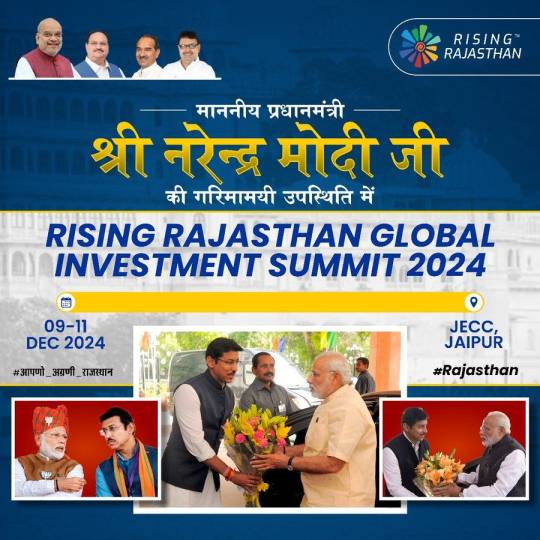
From December 9 to 11, 2024, Rajasthan witnessed an extraordinary event that set the stage for the state’s future in global investment and development — the Rising Rajasthan Global Investment Summit 2024. This prestigious summit, held at the JECC (Jaipur Exhibition & Convention Center), Jaipur, was graced by the presence of none other than Hon’ble Prime Minister Shri Narendra Modi, whose visionary leadership continues to steer the state and the nation towards unprecedented growth.
Under the banner of #आपणो_अग्रणी_राजस्थान (Our Leading Rajasthan), the summit focused on showcasing the immense potential of Rajasthan as a major player in India’s economic transformation, while also highlighting its cultural and tourism prominence on the global stage. With PM Modi’s support and participation, the event aimed to attract investors, entrepreneurs, and innovators to the state, paving the way for new opportunities, collaborations, and partnerships.
A Vision for Rajasthan’s Future
The Rising Rajasthan Global Investment Summit 2024 was not just another conference; it was a statement of intent — a declaration that Rajasthan is no longer merely a land of historical monuments, forts, and deserts. Rajasthan is now an emerging hub for business, investment, and innovation.
PM Modi, in his keynote address, spoke of Rajasthan’s significant role in India’s development story. He emphasized that the state is now well-positioned to be a leader in sectors such as renewable energy, manufacturing, infrastructure development, and tourism. Rajasthan, with its vast natural resources, skilled workforce, and progressive policies, is ready to embrace the future with open arms, welcoming both domestic and global investors.
The Prime Minister’s presence at the event underscored the government’s commitment to fostering a favorable environment for business and entrepreneurship in the state. Through his words, PM Modi assured investors of the stability, reliability, and growth potential of Rajasthan. He highlighted that the state’s future will be built on the pillars of innovation, sustainability, and inclusivity.
Key Themes of the Summit
The summit brought together industry leaders, government officials, and entrepreneurs to discuss key sectors that hold promise for Rajasthan’s future growth. Some of the core themes and discussions included:
Renewable Energy Leadership: Rajasthan is already a leader in India’s solar energy revolution. With its vast open spaces and abundant sunlight, the state is poised to become a global hub for renewable energy investments. The summit focused on attracting investments in solar, wind, and green hydrogen projects.
Infrastructure Development: With initiatives like the Delhi-Mumbai Industrial Corridor (DMIC), Rajasthan is focusing on becoming a logistics and manufacturing powerhouse. The summit discussed large-scale infrastructure projects, including smart cities, transportation, and industrial zones, that will drive economic growth in the region.
Tourism & Cultural Heritage: Known for its royal heritage, majestic forts, palaces, and vibrant culture, Rajasthan continues to be one of India’s top tourist destinations. The summit highlighted opportunities in eco-tourism, adventure tourism, and heritage conservation, ensuring that the state remains a major attraction for global tourists.
Agriculture and Agri-Tech: As one of the largest producers of grains, pulses, and spices in India, Rajasthan is also focused on enhancing its agricultural sector through innovation in technology. Discussions revolved around boosting agricultural productivity, introducing sustainable farming techniques, and promoting agri-tech solutions.
Skill Development and Employment: Rajasthan is investing heavily in skill development to equip its youth with the skills needed for the future economy. The summit discussed strategies for improving education, training, and employment opportunities for the state’s growing workforce.
A Call for Global Partnerships
One of the standout messages of the Rising Rajasthan Global Investment Summit 2024 was the call for collaboration and partnership. PM Modi highlighted that Rajasthan’s growth would not be possible without the involvement of global businesses and investors. The summit served as a platform for networking, forging partnerships, and opening doors to new possibilities. By creating an ecosystem that encourages innovation, research, and development, Rajasthan is becoming an ideal destination for businesses looking to expand their footprint in India and the larger Asian market.
Rajasthan’s government is committed to providing the right infrastructure, policies, and incentives to create a conducive environment for business. With a focus on ease of doing business, robust legal frameworks, and transparent governance, the state is positioning itself as one of the most investor-friendly regions in India.
The Future is Bright for Rajasthan
The Rising Rajasthan Global Investment Summit 2024 was a defining moment for the state’s journey towards economic transformation. With PM Modi’s strong endorsement, Rajasthan is set to rise as a symbol of growth, sustainability, and innovation. The summit not only focused on attracting investments but also highlighted the state’s potential as a dynamic and reliable partner for global businesses.
The summit’s theme, #आपणो_अग्रणी_राजस��थान (Our Leading Rajasthan), reflects the spirit of pride and determination that the people of Rajasthan share as they look towards a future full of opportunities. Whether in renewable energy, infrastructure, tourism, or agriculture, Rajasthan is ready to lead, inspire, and make its mark on the global map.
As the summit concluded, it was clear that Rajasthan’s growth trajectory is just beginning. The state is rising, and with the commitment of its government, the support of Prime Minister Modi, and the active involvement of investors and entrepreneurs, Rajasthan is set to become one of India’s leading states in terms of investment, development, and innovation.
The Rising Rajasthan Global Investment Summit 2024 was a resounding success that showcased the state’s ambitions, opportunities, and path forward. With PM Modi’s leadership and the strong vision of Rajasthan’s government, the state is ready to harness its full potential. The event was a reminder that Rajasthan is not just Rising — it is becoming Reliable, Refined, and ready for the future.
As Rajasthan continues to evolve and innovate, the world is watching. The state is now on the global stage, and it’s clear that Rajasthan is ready to lead — not just within India, but across the world.
3 notes
·
View notes
Text
Tourist Places Near Jaipur Within 100 kms

Sambhar Lake: Located about 71 km from Jaipur, Sambhar Lake is India’s largest inland Salt Lake, spread over 230 sq km. The vast expanse of salt pans shimmering in the sun is a surreal sight. Sambhar Lake is a birdwatcher’s paradise, especially in winters when flamingos and other migratory birds come here.
Khatu Shyam Ji Temple: 90 km from Jaipur, Khatu Shyam Ji Temple is a sacred place of pilgrimage dedicated to a form of Lord Krishna, Shyam Baba. Famous for its beautiful marble architecture and spiritual vibe which attracts thousands of devotees every year.
Bhangarh Fort: Bhangarh Fort is one of the most haunted places in India, 83 km from Jaipur. Built in the 17th century by Raja Madho Singh, the fort is in ruins but still many tourists visit. Haunted stories and paranormal activities associated with the fort have made it a hot spot for ghost hunters, thrill seekers and history lovers.
Chand Baori: 92 km from Jaipur in the village of Abhaneri lies Chand Baori, one of the biggest and most complex stepwells in India. Built over a thousand years ago this architectural wonder has 3,500 steps that go 13 storeys deep in a perfect geometric pattern. Originally built to provide water to the dry land and used to serve as a community center.
Book your transportation from Best Rajasthan Tour Operators in Jaipur and get the best experience of road trip with full comfort and luxury within the budget.
2 notes
·
View notes
Text
A Reflection on Freedom, Unity, and Progress independence day 2024 celebration ideas for office
Introduction
Independence day celebration ideas for office is more than only a date at the calendar; it’s a effective image of freedom, cohesion, and the iconic spirit of a state. As India celebrates its 77th Independence Day on August 15, 2024, it's miles an possibility to reflect on the adventure of this tremendous and numerous u . S . A .—from the struggles and sacrifices of the past to the achievements and demanding situations of the present. This day not handiest commemorates the quit of British colonial rule in 1947 however additionally serves as a reminder of the obligations that include freedom.


The Historical Significance of Independence Day
Best Independence Day food recipes marks the end result of a long and onerous battle for freedom. The British East India Company started out its rule over India in 1757, and through the mid-19th century, the British Crown had taken direct manipulate of the usa. For almost 200 years, India endured colonial exploitation, financial complication, and the suppression of its people.
The Indian freedom war became characterised by using various movements and uprisings, from the Sepoy Mutiny of 1857 to the non-cooperation motion, civil disobedience, and the Quit India Movement led via Mahatma Gandhi. These movements galvanized millions of Indians, united them of their demand for independence, and paved the manner for the eventual cease of British rule.
On August 15, 1947, India ultimately gained independence. Jawaharlal Nehru, the primary Prime Minister of India, marked the event together with his well-known speech, “Tryst with Destiny,” wherein he stated India’s awakening to lifestyles and freedom. Since then, Independence Day has been celebrated every 12 months with remarkable fervor and patriotism.
Celebrations Across the Nation
Independence Day activities for families in India is celebrated with a big selection of activities, ceremonies, and cultural activities. The most iconic party takes region at the Red Fort in Delhi, where the Prime Minister hoists the national flag and addresses the country. This event is attended by way of dignitaries, government officers, and hundreds of citizens, while thousands and thousands more watch the lawsuits on tv.
The national flag, a image of India’s sovereignty and delight, is hoisted in schools, schools, government homes, and houses throughout the u . S . A .. Parades, cultural applications, and patriotic songs are necessary components of the celebrations, with groups coming collectively to honor the freedom combatants and the country’s journey to independence.
In addition to the legitimate occasions, Independence Day is also a time for individuals and households to have a good time of their very own methods. People often put on the tricolor, take part in flag-hoisting ceremonies of their neighborhoods, and percentage messages of patriotism on social media. The day serves as a reminder of the sacrifices made through endless people for the u . S .’s freedom and the want to maintain and cherish that hard-won liberty.
Independence Day 2024: A Time for Reflection
As India celebrates its 77th Independence Day in 2024, it is vital to reflect on the development made in view that 1947 and the challenges that lie beforehand. The state has come a long manner in terms of economic growth, technological advancements, and social development. However, the journey of independence is ongoing, as the united states of america continues to try for extra team spirit, equality, and prosperity.
Economic Growth and Development
Since gaining independence, India has converted from a in large part agrarian economic system into one of the international’s largest and quickest-growing economies. The u . S . Has made sizeable strides in various sectors, such as era, manufacturing, offerings, and agriculture. The upward thrust of the Indian IT enterprise, the increase of the middle magnificence, and the expansion of infrastructure are only a few examples of the kingdom’s progress.
In 2024, India is poised to hold its financial increase, with a focus on sustainability, innovation, and inclusivity. The government’s efforts to boost the manufacturing sector via projects like “Make in India,” the emphasis on digitalization, and the frenzy for renewable electricity are shaping the future of the kingdom’s economic system. However, challenges consisting of earnings inequality, unemployment, and environmental degradation continue to be and require sustained efforts to deal with.
Social Progress and Challenges
India’s adventure toward social development has been marked with the aid of large achievements, however additionally by way of ongoing demanding situations. The u . S . A . Has made high-quality development in education, healthcare, and poverty discount. Government packages just like the National Rural Employment Guarantee Act (NREGA), the Swachh Bharat Abhiyan (Clean India Mission), and the Pradhan Mantri Awas Yojana (Housing for All) have had a high quality effect on millions of lives.
However, troubles including gender inequality, caste-based discrimination, and communal tensions hold to have an effect on the social material of the united states of america. Independence Day 2024 is a time to reaffirm the dedication to social justice, equality, and human rights. It is a reminder that the genuine essence of independence lies in making sure that every citizen, regardless of their heritage, has the opportunity to live with dignity and recognize.
Unity in Diversity
One of India’s finest strengths is its variety. With over 1.Three billion humans, 29 states, masses of languages, and a multitude of cultures and religions, India is a colourful mosaic of different identities. Independence Day is a party of this diversity and the solidarity that binds the nation together.
In 2024, as India faces worldwide demanding situations consisting of weather trade, geopolitical tensions, and economic uncertainties, the spirit of harmony will become even greater essential. The state have to come collectively to address these demanding situations at the same time as respecting and embracing the variety that defines it.
The Role of Youth in Nation-Building
The teens of India have usually performed a essential position in shaping the nation’s destiny. In 2024, with over 65% of the populace beneath the age of 35, the kids continue to be the driving pressure behind the u . S .’s development. Independence Day is an opportunity to encourage and empower the younger era to absorb the mantle of management and contribute to kingdom-building.
Young Indians are increasingly more involved in social, economic, and political spheres, riding exchange thru innovation, entrepreneurship, and activism. Whether it’s through technological advancements, social tasks, or political participation, the teenagers are at the vanguard of shaping a extra inclusive and progressive India.
Looking Ahead: The Future of India
As India celebrates its 77th Independence Day crafts for kids , it's far critical to appearance beforehand to the future and envision the sort of state we aspire to be. The challenges of the 21st century require progressive answers, collaborative efforts, and a commitment to the values of freedom, democracy, and justice.
India’s destiny lies in its ability to harness its human potential, protect its environment, and ensure that monetary boom benefits all sections of society. It is a destiny where generation is leveraged for social right, where schooling and healthcare are handy to all, and in which each citizen has the opportunity to thrive.
Independence Day 2024 is a moment to resume the pledge to uphold the beliefs of the liberty battle—equality, justice, and fraternity. It is a time to keep in mind that independence isn't always just about political freedom, but additionally approximately the liberty to pursue our dreams, to live without fear, and to make a contribution to the collective progress of the kingdom.
#independence day 2024 celebration ideas for office#Independence Day crafts for kids#Independence Day activities for families#Best Independence Day food recipes
2 notes
·
View notes
Text
Jamta Hills, located in Himachal Pradesh, India, is a serene and picturesque destination perfect for a peaceful getaway. This beautiful area is known for its lush greenery, rolling hills, and tranquil atmosphere. Visitors to Jamta Hills can enjoy breathtaking views of the surrounding landscape and experience a sense of calm and relaxation. The region is also home to several hidden gems and offbeat places near Chail, making it an ideal spot for those looking to explore less-traveled paths and discover the natural beauty of Himachal Pradesh.

One of the must-visit places to visit near Jamta Hills is Renuka Lake. Renuka Lake, the largest lake in Himachal Pradesh, is a stunning natural attraction surrounded by dense forests and rolling hills. The lake's serene waters and the surrounding lush greenery create a perfect setting for boating, picnicking, and leisurely walks. Another nearby attraction is the Renuka Wildlife Sanctuary, which is home to various species of animals and birds. Visitors can enjoy wildlife spotting and nature walks in this pristine sanctuary.
Another enchanting destination near Jamta Hills is the Suketi Fossil Park, also known as the Shivalik Fossil Park. This unique park is famous for its rich collection of fossils and life-sized models of prehistoric animals. It offers a fascinating glimpse into the region's ancient past and is an exciting spot for both children and adults. For those interested in exploring more places to visit near Jamta Hills, the nearby Jaitak Fort provides a historical touch with its impressive architecture and panoramic views of the surrounding valleys, making Jamta Hills a wonderful destination for nature lovers and history enthusiasts alike.
#clearholidays#Jamta Hills#places to visit near Jamta Hills#Jamta Hills tourism#Jamta Hills travel guide#himachal pradesh#india#india travel#india tourism#incredible india
3 notes
·
View notes
Text
Top 5 Travel Destinations in India
India, a land of diverse cultures, breathtaking landscapes, and rich history, offers travelers an array of enchanting destinations waiting to be explored. From the snow-capped peaks of the Himalayas to the pristine beaches of Goa, here are some of the best travel destinations in India that should be on every traveler’s bucket list:
Leh-Ladakh, Jammu & Kashmir: Nestled amidst the majestic Himalayas, Leh-Ladakh is a paradise for adventure enthusiasts and nature lovers alike. From trekking in the scenic valleys of Nubra and Pangong to exploring ancient monasteries and witnessing the surreal beauty of the Magnetic Hill, Leh-Ladakh offers a truly unforgettable experience.
Goa: Known for its vibrant nightlife, pristine beaches, and Portuguese heritage, Goa is a favorite destination for travelers seeking sun, sand, and relaxation. Whether you’re lounging on the sandy shores of Anjuna Beach, partying the night away at one of the beach clubs in Baga, or exploring the historic churches of Old Goa, there’s something for everyone in this coastal paradise.
Kerala: Dubbed “God’s Own Country,” Kerala is renowned for its lush greenery, tranquil backwaters, and picturesque hill stations. Cruise along the serene backwaters of Alleppey in a traditional houseboat, trek through the tea plantations of Munnar, or rejuvenate your mind and body with an Ayurvedic massage at one of the many wellness retreats dotted across the state.
Rajasthan: Immerse yourself in the royal heritage and colorful culture of Rajasthan, India’s largest state. Explore the majestic forts and palaces of Jaipur, ride a camel through the golden sands of the Thar Desert in Jaisalmer, or witness the stunning sunset over the blue city of Jodhpur from the towering Mehrangarh Fort.
Varanasi, Uttar Pradesh: Considered one of the oldest cities in the world, Varanasi is a sacred destination for Hindus and a fascinating cultural experience for travelers. Take a boat ride along the sacred Ganges River, witness the mesmerizing Ganga Aarti ceremony at Dashashwamedh Ghat, and explore the narrow lanes of the ancient city dotted with temples and ghats.
Conclusion: With its myriad of enchanting destinations, India offers travelers a wealth of experiences waiting to be discovered. Whether you’re seeking adventure in the mountains, relaxation on the beach, or immersion in rich cultural heritage, India has something to offer for every type of traveler. So pack your bags, embark on a journey of exploration, and experience the magic of India firsthand.
#best travel agent in india#best travel destinations in india#best tour and travel agents in pcmc#best travel agent in pcmc#tourism#best travel destinations for honeymoon couples#tour and travel operator near me#best travel destinations for family#destination holiday tours#best travel destinations for family pcmc
2 notes
·
View notes
Text



Jodhpur blue houses and alleys
India
Jodhpur, the city of colours is famous for its heritage,culture,architecture and many more such things.The most vibrant thing to experience is the blue streets at the old part of jodhpur city.
The second-largest city in the Indian state of Rajasthan. Apart from being a popular tourist destination, it is also famous for its palaces, historical temples, and historical fort, which have been located in the Thar Desert for centuries. The old city is surrounded by the walls of Mehrangarh Fort and many gates. However, the city was confined within the city fort walls at that time, but with time the city of Jodhpur expanded. It is known as the "Blue City" in India and Rajasthan. Meanwhile, this beautiful old city and its blue houses surprise everyone who sees it!
The vibrant and blue city will definitely chase away the monday blues. As Rajasthan being the colourful state of India as Jaipur being the pink city,Jodhpur being the blue city and Jaisalmer being the golden city. The cultural clothes of Rajasthani people are also bright and full of colours.
3 notes
·
View notes
Text
Discover the Mystical Kingdoms of Myanmar and Oman with a Tour Package
Embarking on a journey to explore the enchanting landscapes and rich cultural tapestries of Myanmar and Oman is a dream for many avid travelers. These two countries, each boasting a unique charm and history, offer a perfect blend of ancient traditions and modern wonders. To make the most of your exploration, consider opting for a well-curated Myanmar or an Oman Holiday package from India.

Myanmar: A Land of Timeless Beauty
Myanmar, formerly known as Burma, is a country steeped in mystique and allure. From the awe-inspiring temples of Bagan to the serene waters of Inle Lake, Myanmar is a treasure trove of cultural and natural wonders. A well-organized Myanmar Tour Package allows you to immerse yourself in the splendor of this mystical kingdom.
Begin your journey in Yangon, the largest city in Myanmar, where the iconic Shwedagon Pagoda stands tall, adorned in gold and precious jewels. Explore the bustling markets, sample local delicacies, and absorb the city's vibrant atmosphere. The tour package may include a visit to the ancient city of Bagan, home to thousands of ancient temples and pagodas that paint a mesmerizing silhouette against the sunrise and sunset.
Mandalay, another gem in Myanmar's crown, offers a glimpse into the country's royal history. From the Mandalay Palace to the U Bein Bridge, the city resonates with a sense of regality. Inle Lake, with its floating gardens and unique leg-rowing fishermen, showcases a more serene side of Myanmar's beauty.
A well-organized Myanmar Tour Package ensures that you don't miss out on the hidden gems, such as the off-the-beaten-path villages and the picturesque landscapes that dot the countryside. Whether you're an avid history buff, nature lover, or cultural enthusiast, Myanmar has something to offer for every traveler.
Oman: A Tapestry of Contrasts
Nestled on the southeastern coast of the Arabian Peninsula, Oman is a destination where tradition seamlessly intertwines with modernity. The country's diverse landscapes, from the golden dunes of the Wahiba Sands to the rugged peaks of the Hajar Mountains, make it a haven for nature enthusiasts. Oman Holiday Packages From India provide an excellent opportunity to explore this contrasting paradise.
Muscat, the capital city, is a blend of ancient charm and contemporary elegance. The Sultan Qaboos Grand Mosque, a testament to Omani architecture, and the Mutrah Souq, a bustling market with a rich array of goods, are must-visit attractions. The coastal city of Salalah, with its lush greenery and historic sites, offers a different perspective of Oman's beauty.
A tour package to Oman might include a journey into the Wahiba Sands, where you can experience a thrilling desert safari and witness the mesmerizing sunset over the vast expanse of golden dunes. The ancient city of Nizwa, surrounded by mountains and date palm plantations, is a gateway to Oman's cultural heritage, featuring a historic fort and a lively souq.
Oman's coastline is dotted with pristine beaches, and the opportunity to explore the underwater world through snorkeling or diving is a highlight for adventure seekers. The unique blend of ancient traditions and modern developments in Oman makes it a destination that caters to a diverse range of interests.
Choosing the Right Package for Your Journey
Both Myanmar and Oman offer an immersive experience that goes beyond the typical tourist attractions. When considering Myanmar Tour Packages or Oman Holiday Packages From India, it's essential to choose a package that aligns with your interests and preferences. Look for packages that offer a balance between guided tours to iconic landmarks and opportunities for spontaneous exploration.
In conclusion, the mystical kingdoms of Myanmar and Oman beckon travelers with their rich histories, diverse landscapes, and warm hospitality. Whether you're captivated by the ancient temples of Myanmar or the contrasting beauty of Oman, a thoughtfully designed tour package ensures that your journey is seamless and memorable. Embark on an adventure of a lifetime and uncover the secrets of these enchanting destinations.
3 notes
·
View notes
Text
Top 10 Visiting Place in Ahmedabad
Ahmedabad is a vibrant city that offers a rich blend of history, culture, and modern attractions. Here are the top 10 places to visit in Ahmedabad":
Swaminarayan Temple: This magnificent temple is one of the most popular tourist attractions in Ahmedabad. It is dedicated to Lord Swaminarayan, and is known for its intricate carvings and beautiful architecture.
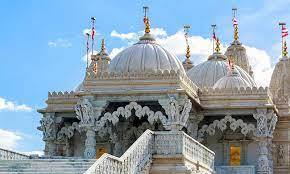
2. Bhadra Fort: This 15th century fort is one of the oldest and most iconic landmarks in Ahmedabad. It is now a museum that houses a collection of artifacts and exhibits that tell the story of the city's history.

3. Sabarmati Ashram: This ashram was the home of Mahatma Gandhi for many years, and is now a museum that commemorates his life and work. Visitors can see Gandhi's personal belongings, and learn about his philosophy of non-violence.

4. Sabarmati Riverfront: This is a beautiful stretch of land along the Sabarmati River that has been developed into a popular recreation area. Visitors can enjoy walking, jogging, cycling, and boating here.

5. Kankaria Lake: This is a large artificial lake that is a popular spot for boating, picnicking, and enjoying the outdoors. There is also a zoo, an amusement park, and a children's park located on the lakefront.

6. Adalaj Step-well: This is a unique step-well that was built in the 15th century. It is one of the most well-preserved step-wells in India, and is a UNESCO World Heritage Site.

7. Hathee Singh Jain Temple: This is a beautiful Jain temple that is known for its intricate carvings and unique architecture. It is one of the most important Jain temples in India.

8. Jama Masjid: This is one of the largest mosques in India. It is a beautiful example of Indo-Islamic architecture, and is a popular spot for tourists and locals alike.
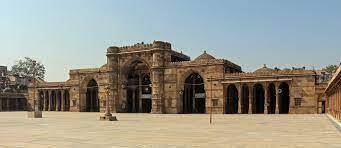
9. Sarkhej Roza: This is a complex of mosques and tombs that was built in the 16th century. It is a beautiful and peaceful place that is worth visiting.
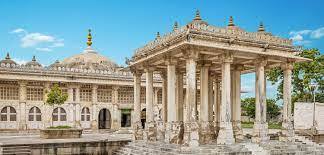
10. Kite Museum: This is a unique museum that is dedicated to the history and culture of kites. It is a fun and educational place that is worth visiting for people of all ages.
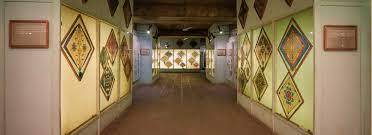
2 notes
·
View notes
Text
Events 11.9 (after 1950)
1953 – Cambodia gains independence from France. 1960 – Robert McNamara is named president of the Ford Motor Company, becoming the first non-Ford family member to serve in that post. He resigns a month later to join the newly-elected John F. Kennedy administration. 1963 – At a coal mine in Miike, Japan, an explosion kills 458 and hospitalises 839 with carbon monoxide poisoning. 1965 – Several U.S. states and parts of Canada are hit by a series of blackouts lasting up to 13 hours in the Northeast blackout of 1965. 1965 – A Catholic Worker Movement member, Roger Allen LaPorte, protesting against the Vietnam War, sets himself on fire in front of the United Nations building. 1967 – Apollo program: NASA launches the unmanned Apollo 4 test spacecraft, atop the first Saturn V rocket, from Florida's Cape Kennedy. 1970 – Vietnam War: The Supreme Court of the United States votes 6–3 against hearing a case to allow Massachusetts to enforce its law granting residents the right to refuse military service in an undeclared war. 1979 – Cold War: Nuclear false alarm: The NORAD computers and the Alternate National Military Command Center in Fort Ritchie, Maryland detected purported massive Soviet nuclear strike. After reviewing the raw data from satellites and checking the early-warning radars, the alert is cancelled. 1985 – Garry Kasparov, 22, of the Soviet Union, becomes the youngest World Chess Champion by beating fellow Soviet Anatoly Karpov. 1989 – Cold War: Fall of the Berlin Wall: East Germany opens checkpoints in the Berlin Wall, allowing its citizens to travel to West Berlin. 1993 – Stari Most, the "old bridge" in the Bosnian city of Mostar, built in 1566, collapses after several days of bombing by Croat forces during the Croat–Bosniak War. 1994 – The chemical element darmstadtium is discovered. 1998 – A U.S. federal judge, in the largest civil settlement in American history, orders 37 U.S. brokerage houses to pay US$1.03 billion to cheated NASDAQ investors to compensate for price fixing. 1998 – Capital punishment in the United Kingdom, already abolished for murder, is completely abolished for all remaining capital offences. 1999 – TAESA Flight 725 crashes after takeoff from Uruapan International Airport in Uruapan, Michoacán, Mexico, killing all 18 people on board. 2000 – Uttarakhand officially becomes the 27th state of India, formed from thirteen districts of northwestern Uttar Pradesh. 2004 – Firefox 1.0 is released. 2005 – The Venus Express mission of the European Space Agency is launched from the Baikonur Cosmodrome in Kazakhstan. 2005 – Suicide bombers attack three hotels in Amman, Jordan, killing at least 60 people. 2012 – A train carrying liquid fuel crashes and bursts into flames in northern Myanmar, killing 27 people and injuring 80 others. 2012 – At least 27 people are killed and dozens are wounded in conflicts between inmates and guards at Welikada prison in Colombo. 2014 – A non-binding self-determination consultation is held in Catalonia, asking Catalan citizens their opinion on whether Catalonia should become a state and, if so, whether it should be an independent state. 2020 – Second Nagorno-Karabakh War: An armistice agreement is signed by Armenia, Azerbaijan and Russia.
2 notes
·
View notes
Text
Gujarat’s Pride: Dholavira’s Archaeological Site, Culture, and History | Evoke Dholavira
Introduction:
Dholavira is a UNESCO World Heritage Site and the largest Harappan site in India. It is located in the Kutch Desert of Gujarat and was discovered in the early 1900s. Excavations at the site have revealed a wealth of information about the Harappan civilization, including its architecture, engineering, and social and economic structure.
Dholavira is a significant archaeological site that offers insights into the Harappan civilization, culture, and history of Gujarat. The site is well-preserved and there is a museum on-site that houses a collection of artifacts from the city.

The Archaeological site of Dholavira:
The Dholavira archaeological site is known for its impressive fortifications, water conservation systems, and public buildings. The Dholavira Fort is one of the largest and most well-preserved Indus Valley Civilization forts in India. It has a massive rampart wall that is over 7 kilometers long and 10 meters thick.
Dholavira is also known for its sophisticated water conservation system. The city had a number of reservoirs, dams, and canals that were used to collect and store rainwater. This system allowed the city to survive during the dry season.
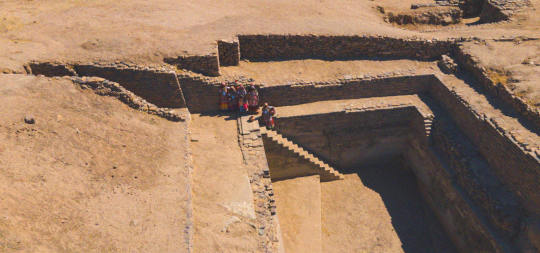
Other notable features of the Dholavira archaeological site include:
The Citadel: The Citadel is the highest point in the city and is thought to have been the center of political and religious power.
The Lower Town: The Lower Town is where most of the city’s inhabitants lived. It contains a variety of residential areas, workshops, and public buildings.
The Great Bath: The Great Bath is a large rectangular pool that is thought to have been used for ritual bathing.
The Signboards: Dholavira is home to a number of inscribed stone slabs that are thought to be signboards. These signboards are in a language that has not yet been deciphered, but they may provide insights into the Harappan civilization.

Some of the key aspects of Harappan culture that are evident at Dholavira include:
Art: Dholavira is home to a variety of art objects, including pottery, seals, and sculptures. The art of Dholavira is known for its geometric designs and animal motifs.
Architecture: The architecture of Dholavira is characterized by its use of brick and mudbrick. The city’s buildings were well-planned and well-constructed.
Religion: The Harappan people practiced a variety of religious beliefs. There is evidence of both Hindu and Buddhist worship at Dholavira.
Trade: Dholavira was a major center of trade and commerce during the Indus Valley Civilization. The city traded with other Harappan cities in India and Pakistan, as well as with Mesopotamia and Persia.
The History of Dholavira:
Dholavira was founded around 3000 BC and flourished during the Harappan civilization. The city was abandoned around 1500 BC, but the ruins of the city were rediscovered in the early 1900s.
Dholavira is a significant site in the history of Gujarat. It is the largest Harappan site in the state and it offers insights into the Harappan civilization, culture, and history of Gujarat.
Conclusion:
Dholavira is a must-visit destination for anyone interested in Indian history and culture. The Dholavira archaeological site offers visitors a unique opportunity to learn about the Harappan civilization and its many achievements. Dholavira Tent City provides all the luxurious facilities and amenities, making it the perfect place to stay while exploring this fascinating site.
Book your stay at Dholavira Tent City today and experience the magic of Dholavira!
#dholavira tent city#dholavira#kutch#gujarat tourism#Harappan civilization#dholavira history#dholavira accommodation#tourist attraction#dholavira tourism#gujarat
2 notes
·
View notes
Text
Eye on Making Investments a Reality: Rajasthan Government’s Strategic Move to Attract Investors

Rajasthan: A Growing Economic Powerhouse
Rajasthan, India’s largest state by area, is home to a diverse economic landscape that ranges from agriculture and mining to tourism and industrial growth. Historically, the state has seen substantial contributions from sectors such as mineral resources, textiles, and craftsmanship. However, with the changing times, the state government has recognized the need to diversify and expand the economy by inviting more modern, high-impact industries, especially in technology, manufacturing, and renewable energy.
Government Initiatives to Attract Investments
The Rajasthan government has been taking a series of proactive measures to make the state a hub for both domestic and foreign investments. These initiatives include:
Investor-Friendly Policies: The government has launched a variety of tax incentives, subsidies, and reduced bureaucratic hurdles to create a more streamlined investment environment. This helps both new startups and established multinational companies to enter the market with ease.
Infrastructure Development: The state has significantly boosted its infrastructure, building robust transportation networks, logistics hubs, and industrial zones in key regions such as Jaipur, Udaipur, and Jodhpur. This development ensures that businesses have access to world-class facilities that facilitate smooth operations.
Dedicated Investment Promotion Units: The Rajasthan government has set up specialized bodies, such as the Rajasthan State Industrial Development and Investment Corporation (RIICO), to act as a one-stop solution for investors. These units help streamline processes related to land acquisition, approvals, and permits.
Focus on Renewable Energy: Rajasthan’s commitment to sustainable energy is also notable. With vast open spaces and favorable climatic conditions, the state has become a leader in solar power generation in India. This attracts investors focused on clean energy solutions.
Col Rajyavarshan Rahtore: A Visionary Leader in the Investment Drive
One of the key figures behind Rajasthan’s investment drive is Col Rajyavarshan Rahtore, whose leadership and strategic insights have helped shape the state’s future. With a background in the Indian Army, Col Rahtore brings a unique perspective to governance and economic development, combining disciplined military strategies with innovative policy-making.
A Strong Advocate for Investor Relations
Col Rahtore is known for his strong advocacy of cultivating good relations with both domestic and international investors. He believes that fostering long-term partnerships with the private sector is crucial to ensuring the state’s economic prosperity. Under his leadership, the government has worked to build trust and create a stable investment climate that encourages both large-scale and small-scale investors.
Collaborative Approach to Investment Promotion
Col Rajyavarshan Rahtore understands that attracting investments goes beyond policy implementation. He has emphasized the need for collaboration between local entrepreneurs, large corporates, and foreign investors. By establishing public-private partnerships, he has played a pivotal role in creating a more inclusive environment for various industries, such as technology, healthcare, education, and manufacturing.
Focus on Sector-Specific Growth
While Col Rahtore’s initiatives have been broad-reaching, he has also directed special attention to specific sectors with the highest potential for growth. These include:
Tourism and Hospitality: Rajasthan has long been a popular tourist destination, known for its palaces, forts, and cultural heritage. Under Col Rahtore’s leadership, the state has focused on developing world-class infrastructure for tourism and hospitality. This includes the construction of modern hotels, resorts, and convention centers that cater to international visitors.
Renewable Energy: With a sharp focus on sustainability, Col Rahtore has played a central role in Rajasthan becoming a leading state in India for solar power generation. The government’s efforts to build large solar parks, such as the Bhadla Solar Park, have attracted significant investment from global renewable energy firms.
Industrial Growth: The government’s push to develop industrial corridors in Rajasthan has opened doors for a range of industries. Special emphasis has been given to attracting automobile manufacturing, pharmaceuticals, electronics, and defense industries to set up shop in the state.
Rajasthan’s Investment Ecosystem: Key Strengths and Opportunities
As the Rajasthan government accelerates its investment initiatives, several aspects of the state’s economic ecosystem make it an attractive proposition for investors. These factors are contributing to the state’s growing reputation as an investment hub.
Strategic Location and Connectivity
Rajasthan’s geographical location in India is one of its key advantages. The state is well-connected to other major Indian markets, as well as global trade routes. With excellent rail, road, and air connectivity, businesses can easily transport goods both within India and abroad. The government has also made substantial investments in improving infrastructure at ports, airports, and highways.
Skilled Workforce and Educational Institutions
Rajasthan is home to several leading educational institutions that produce a highly skilled workforce. These include prestigious engineering colleges, business schools, and medical universities. The state is positioning itself as a key player in producing the next generation of workers in industries like IT, biotechnology, and manufacturing.
Large Consumer Market
With a population of over 80 million people, Rajasthan offers access to a vast and growing consumer market. As incomes rise, there is increasing demand for goods and services in sectors such as consumer electronics, food processing, and healthcare. This provides significant growth potential for companies looking to expand their reach in India.
Conclusion: Rajasthan — A State to Watch for Future Investments
Rajasthan’s strategic initiatives and the leadership of Col Rajyavarshan Rahtore have set the stage for a future where the state becomes one of India’s top destinations for investment. With its investor-friendly policies, focus on infrastructure development, and an eye on key sectors such as renewable energy, tourism, and manufacturing, Rajasthan is well on its way to becoming a beacon of economic growth.
The efforts being made to streamline processes and build strong relationships with investors are already bearing fruit. With more and more companies looking to invest in the state, Rajasthan is poised to realize its potential as a significant economic powerhouse in India’s growth story. As Col Rajyavarshan Rahtore continues to guide the state forward, there is no doubt that Rajasthan will remain a key player in shaping the country’s economic future.
3 notes
·
View notes
Text
Dubai is known for several popular tourist attractions, including:
Burj Khalifa: The world’s tallest building, offering stunning views from its observation decks.
The Dubai Mall: One of the largest malls globally, featuring countless shops, restaurants, and entertainment options, including an indoor ice rink and an aquarium.
Palm Jumeirah: An artificial palm-shaped island with luxury resorts, shopping, and dining options.
Dubai Marina: A modern canal city with waterfront promenades, restaurants, and high-rise buildings.
Burj Al Arab: A luxury hotel shaped like a sail, known for its opulent design and breathtaking views.
Dubai Fountain: An impressive choreographed fountain show set to music, located next to the Burj Khalifa and Dubai Mall.
Desert Safari: Experience the desert with activities like dune bashing, camel rides, and traditional performances.
Jumeirah Beach: A popular spot for relaxing and enjoying the sun and sea.
Dubai Creek: A historic area where you can take a traditional abra (boat) ride and explore the old markets.
Dubai Museum: Housed in Al Fahidi Fort, this museum offers insights into Dubai’s history and culture.
Remember, Dubai has much more to offer beyond these highlights. It’s a dynamic city that blends modernity and tradition, making it a fascinating destination for tourists.
2 notes
·
View notes